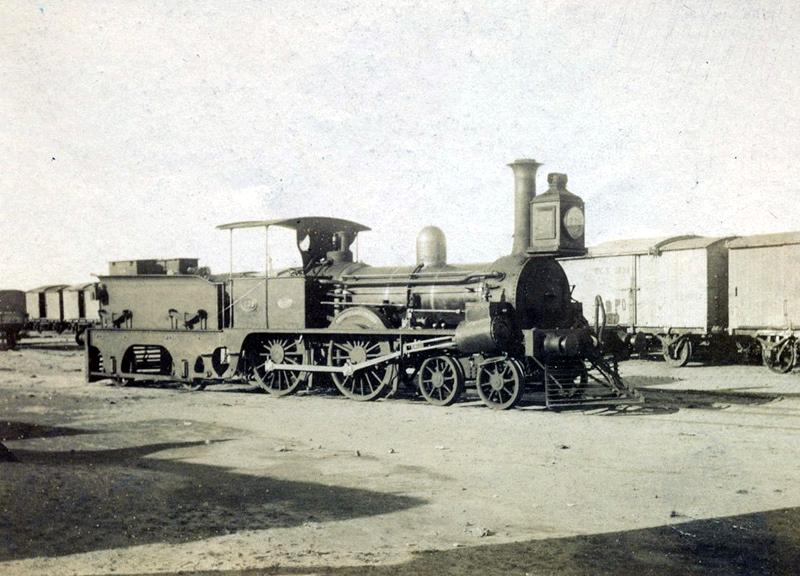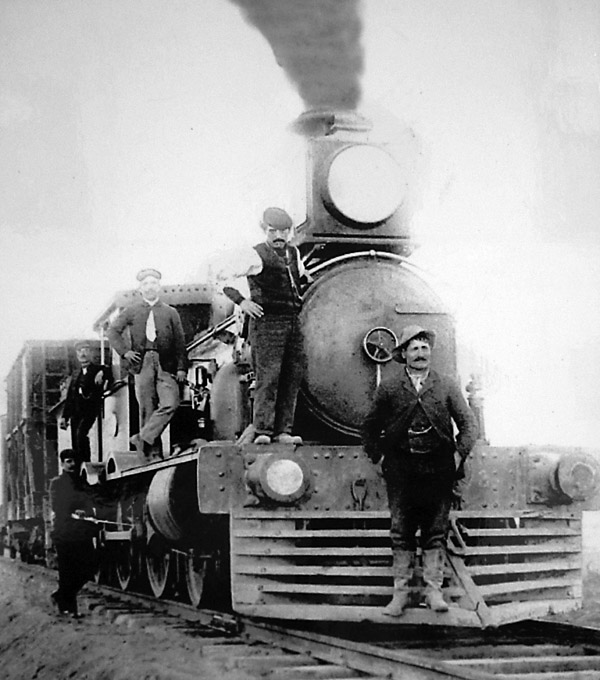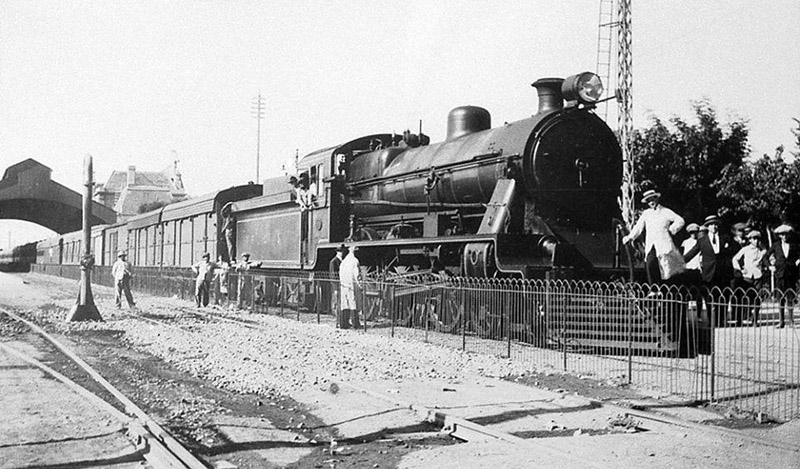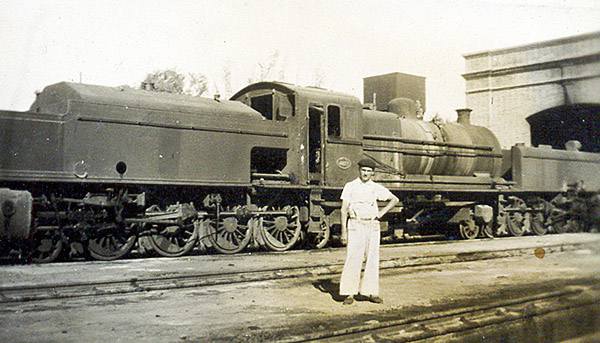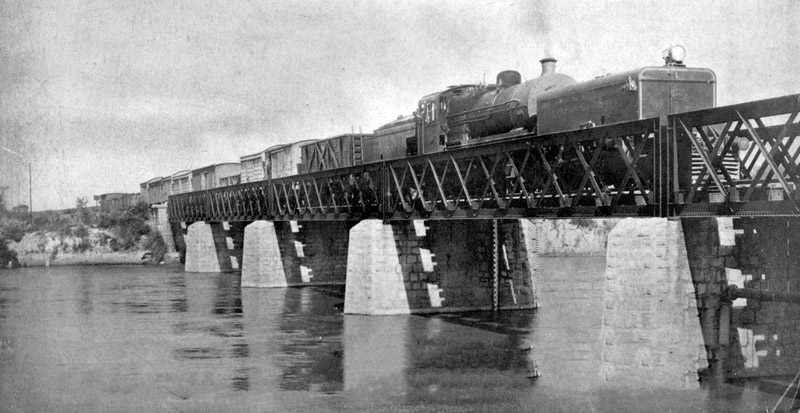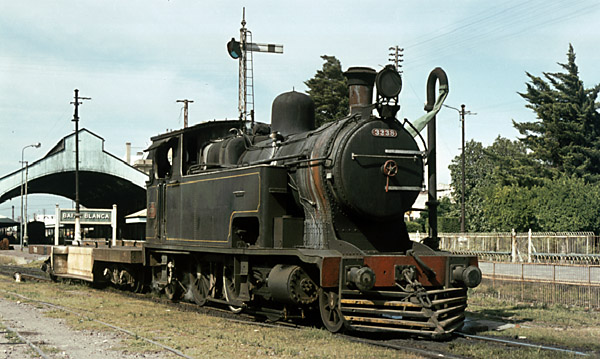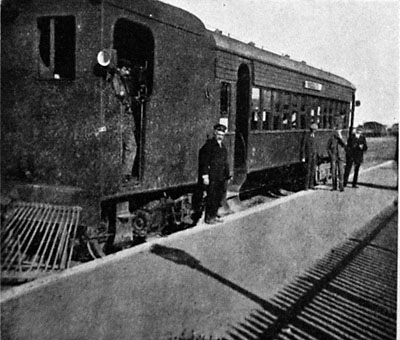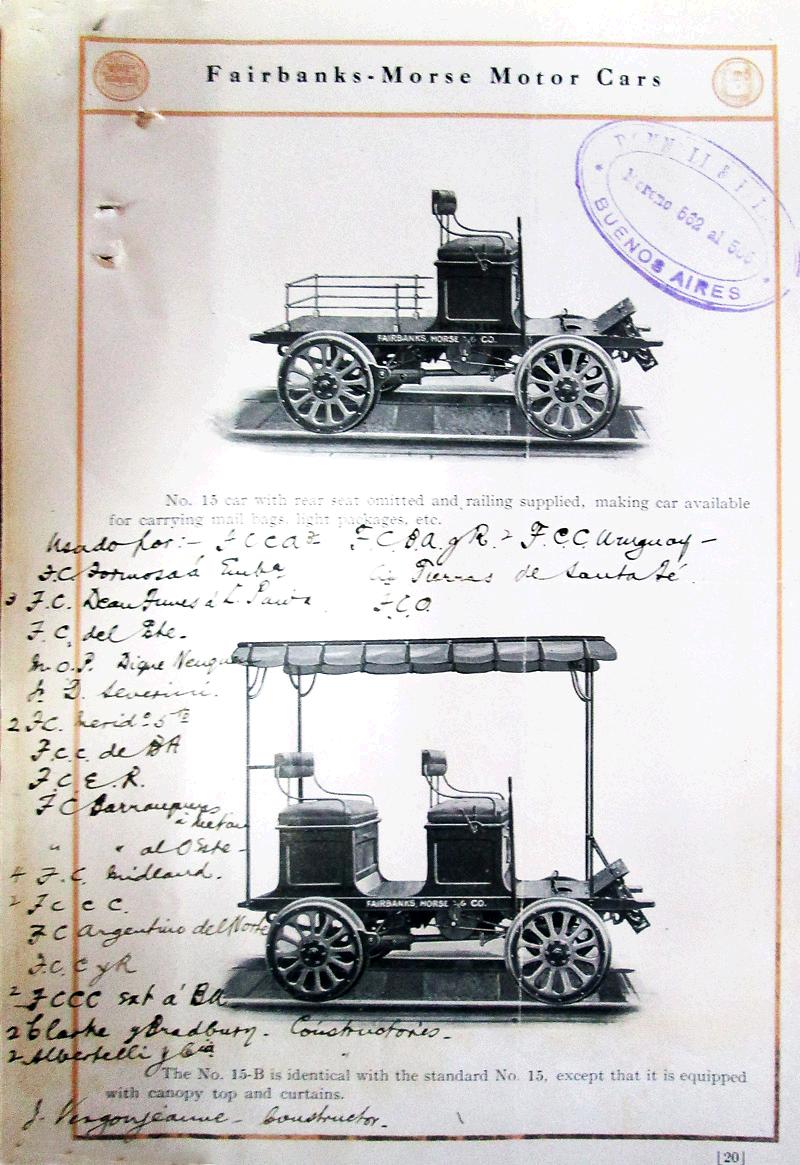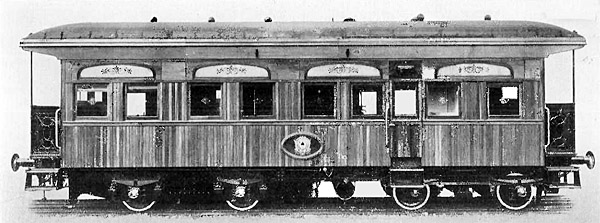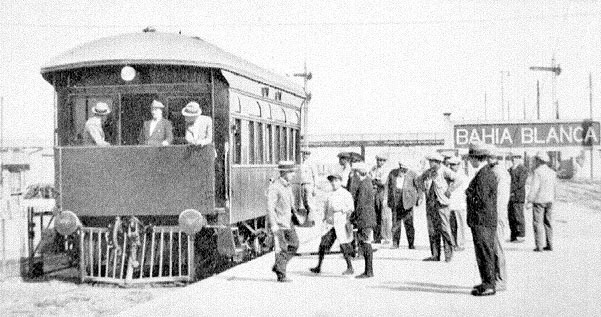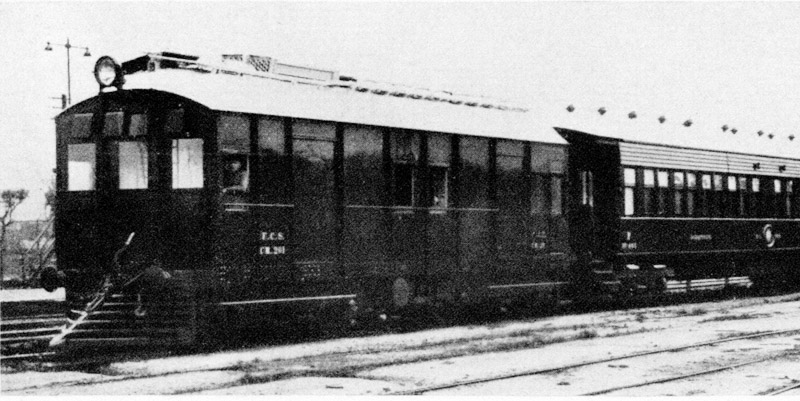 |
||||||||||||||||
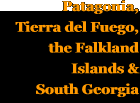 |
||||||||||||||||
 |
||||||||||||||||
 |
||||||||||||||||
BAGS locos used on the route From the archive of Héctor Guerreiro comes this rather archaic looking locomotive, No 239, which was engaged on the construction trains when building the line to Neuquén. It had started life in 1883 as La Primera Argentina, No 48, of the FC Oeste and was bought by the FC Sud in 1899 for the Neuquén line construction. On completion of the line it, worked around Ingeniero White until its scrapping in 1906.
This is a photo found in the web site which commemorates the centenary of the city of Neuquén. I think the engine may be a FCS class 6B. The wagon behind the tender is an additional water tank for loco supply, with a high mounted tank to ensure an efficient gravity feed. (2) [This photo belongs to an unrelated website, which can be accessed directly by clicking on the image.] Another photograph found in the same site. Clearly it is in Neuquén station. Is it also a class 6B? The wagon to its right is interesting; it is a 9.575 tonne tare brake van with a 5 tonne capacity for parcels. It was built by the Birmingham Carriage and Wagon Co in 1889; one survived long enough to be included in the FC Roca Z2 class of brake vans. The use of such road vans meant that a secure parcels service could be provided by goods trains in place of the more usual UK practice of using passenger trains. (2) [This photo belongs to an unrelated website, which can be accessed directly by clicking on the image.] Another photo of an FCS 4-4-0, also with an extra water tank behind the tender ().
This imposing view shows the arrival of the train from Buenos Aires at Bahía Blanca Sud on 8 February 1927. The locomotive is class 12E N° 3923. There are no less than four vans at the head of the train. We do not know why there are two men wearing straw hats and white coats in the picture. (0A)
The Garratts Basic dimensions of the Garratts were: cylinders 17½" x 26"; driving wheels 4'-7½"; boiler pressure 200 lb/sq in; tractive effort (80%) 45,910 lb; oil capacity 8 tons; water capacity 4,600 gallons. A Beyer Peacock photo shows one of the Garratts before delivery.
This clearly posed view shows one of the Garratts with a Class 17 brake van in charge of an oil train traversing the timber trestle viaduct between the big bridge over the Neuquén and the station of Cipolletti.
This is a view of one of the Garratts at Ingeniero White shed, showing the openings at the rear of the cab.
The Garratts were not outstandingly successful, partly because the loads they needed to haul to reap the benefit of their full power were too long for the loops. As a result they seem to have had a fairly short life. This is a view of of an unidentified Garratt on the bridge over the Río Colorado. The train, which it is hauling, seems remarkably short, being made up mostly of 4-wheel vans. In addition to the usual headlamp there appears to be an oil lamp mounted on the offside of the tank. The purpose of this lamp is not known. Behind the engine is one of those wooden bodied water-carriers which are seen in most train photographs of the Neuquén line from the earliest times. Behind the water-carrier is a road van with the guard standing in the doorway. The piers of the bridge are constructed of stone. On the pier under the engine is a depth gauge for the water. (0B)
The 'Fruteras' The Class 15A comprised 8 engines built by the Vulcan Foundry in 1939, four had Walshaerts and four had Caprotti valve gear. This latter valve gear was replaced by the Walshaerts variety during the Second World War due to the unavailability of spare parts for it. The Class 15B were an updated version: some 30 engines, also from the Vulcan Foundry, arrived in Argentina very shortly after nationalization. Apart from a weight in working order of 153.6 tons as against the 155.3 tons of the earlier ones, their principal dimensions were the same. Basic dimensions were: Cylinders 19½" x 28", Driving wheels 5'-8", Boiler pressure 225 lb/sq in, Tractive effort (80%) 28, 200 lb, Oil capacity 11, 481 kg (11½ tons), Water capacity 27, 240 litres (6, 000 gallons) The web site Por los rieles del Sud, with address <http://www.porlosrielesdelsud.com.ar/locoayer.html> (Not available in April 2012) has data on some of the FCS engines, particularly classes 15A and 15B (4-8-0 engines with bogie tenders) (5). The site has its origins in an article by Richard Campbell “Las locomotoras fruteras de los ferrocarriles Sud y Oeste”, in the Revista Ferroclub Nº19 of November 1994. (6). Tank locos This picture was taken at the north end of Bahía Blanca station in 1975.
Other locomotives In the early days all the locomotives used coal from Cardiff as fuel. As time went on, many were converted to burn crude oil. The coal was imported to Bahía Blanca, indeed the FC Sud owned and operated a number of colliers; however, rather than send them back in ballast they took whatever cargo they could secure, eg potatoes. This view shows a number of wooden-bodied bogie wagons loaded with coal, some of which was in quite big lumps; in the foreground are a number of empty steel-bodied bogie wagons awaiting loading. In the background are the grain handling installations at Ingeniero White. Incidentally the loaded wagon to the left shows an earlier version of livery with SUD in smaller letters rather than the big letter S at the right hand end of the metal wagon in the foreground. Our thanks to Héctor Guerreiro for this view. (0C)
Early Railcars In this view, taken by Arthur Coleman, the buffers have been removed. (2A)
Nº1 appears to have recently entered service, but not in the Río Negro valley. One can see that the coach is carried by a single bogie and is supported at the other end by the power unit. The livery of the bodywork can be clearly seen. What colour was it? (2B) [This photo belongs to an unrelated website, which can be accessed directly by clicking on the image.] This view appears in the Todo Trenes magazine. One car see that it has a transverse boiler, not a front to back one which is usual on railway engines. It has neither buffers nor cattle guard. (2C) Stranger on the Line As this is the only broad gauge stock which we know about for the irrigation scheme, it is a little hard to know whether to include it here or along with the narrow gauge material. The writing on the un-cropped view notes the lines which made use of this Fairbanks-Morse No. 15 type trolley. The notes included a reference to a broad gauge one for MOP works on the Dique Neuquén – presumably to operate on the FCS lines!
Drewry Officers' Railcar Héctor Guerreiro has kindly provided a view of this saloon in service at the north end of Bahía Blanca Sud station. The buffers, coupling and brake pipe allowed it to be attached to a train.
Early diesel locos
Workshops References: 27-1-2018 |
||||||||||||||||
Main pages
Appendices
Chapter 3
The BAGSR's route to Neuquén


